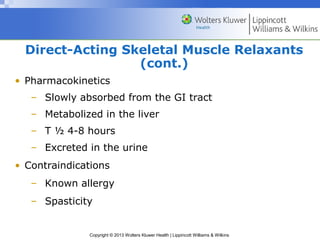This document discusses muscle relaxants and their use and mechanisms. It covers different types of spinal reflexes and fibers that control muscle movement. Muscle spasm and spasticity are described as being caused by changes in the central nervous system. Most muscle relaxants work in the brain and spinal cord by interfering with reflexes causing spasm. Direct-acting relaxants enter muscle fibers and interfere with calcium release and contraction. Centrally-acting relaxants are absorbed and metabolized quickly while direct-acting ones have a longer half-life. Common side effects and drug interactions are provided. Nursing considerations for the different types of relaxants are also mentioned.

























